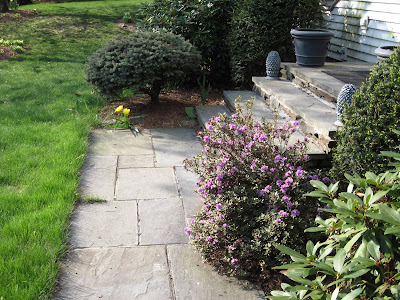Now, more garden pictures. These are two views from similar angles taken about 2 weeks apart, showing the relatively rapid growth and "greening" at this time of year:


Here you can see, among other plants, some of the hostas unfolding their leaves, and the Ostrich fern uncoiling its fronds. (The Ostrich fern was planted in a single spot 5 years ago. It's a "colony plant" that spreads through underground runners, and each year appears in one or two places where it didn't the year before.)

Another flower bed - this one has, among other plants, irisis, astilbe, peonies, spirea, echinacea (purple coneflowers), onions, daisies, rose campion, poppies, and sedum. Hardly any of these plants flower really early in the growing season, so it will be another 3 weeks to a month before this part of the garden starts to break out in lots of color. (The only things flowering here are a single pink hyacinth on the left, and a few pale blue phlox above and a little to the right of the hyacinth.)

Back to a part of the garden that has more early spring flowering action going on - Dicentra spectabilis bleeding hearts in full bloom, along with two different varieties of tulip:

In this next picture, the low lying blue flowers are anemones, which have already been flowering for almost 3 weeks. Above them, an azalea bush is about to start bursting out lots of bright magenta-pink flowers, while at the bottom the white candytuft (Iberis sempervirens) is also starting to flower. Little green sprouts of lily-of-the-valley are coming up around everything, and to the right that the ground is carpeted by the aptly named "grey-leafed, self-spreading plant whose name I can never remember"

There's always a major hazard when you don't put any kind of edging material between a garden bed and the lawn. Most lawn grasses will happily spread into the garden, especially because the mulched, composted, fertilized soil in the garden is probably more fertile than the soil under the lawn itself. If you have a low-growing groundcover plant at the edge of the flower bed, it's almost impossible to pull the spreading grass out without ripping out the plant you want to keep. What you can end up with is this:
 in which the grass has pretty much taken over a chunk of what used to be part of the flower garden, and the actual garden plant (whose name, again, I can't remember - you can see bits of its greyish foliage peeking through the grass) is gradually being crowded out and choked by the faster-growing grass. I can only see two options - dig up everything and replant, or concede that this area is now part of the lawn again and start mowing it as part of the lawn, which will quickly finish off the last bits of the other plant.
in which the grass has pretty much taken over a chunk of what used to be part of the flower garden, and the actual garden plant (whose name, again, I can't remember - you can see bits of its greyish foliage peeking through the grass) is gradually being crowded out and choked by the faster-growing grass. I can only see two options - dig up everything and replant, or concede that this area is now part of the lawn again and start mowing it as part of the lawn, which will quickly finish off the last bits of the other plant.Grass tends to spread more aggressively than most of my garden plants, but occasionally there is a problem going the other way. For example, here the Ostrich fern and a lamium with nice pink flowers both demonstrate a total lack of concern for my arbitrary boundary between flower garden and lawn:

The back of the yard, with the "waste area" between the stone wall and a fence. This has always been a very convenient place to dump clippings, weeds, small fallen branches, etc, and has saved countless trips to a landfill with yard waste over the years. After almost 3 decades of being dumped on like this, the soil is incredibly fertile in this strip - both weeds and "overflow" plants transplanted from the flower beds grow at least as well in the "waste area" as in the formal parts of the garden. Unfortunately, invasive Oriental Bittersweet and native but most unwelcome poison ivy are always creeping in from the other side of the chain-link fence, where I can never get rid of them. Cutting them and other weeds back is a necessary chore at least once or twice per growing season, and preferably more. Without cutting much of the this area would become a tangled mass of weeds in 1 year, and all of it in less than two.

Finally, bushes and a couple of tulips along the front walkway. Oddly, the front yard has far fewer flowering perennials than the back and side yards, partly because it's smaller, partly because much of the available space is taken up by shrubs and small trees instead.

No comments:
Post a Comment